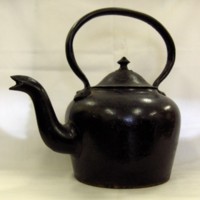An Iron Kettle from the Late 19th Century
Dublin Core
Title
An Iron Kettle from the Late 19th Century
Subject
Newfoundland material artefacts
Description
This kettle was donated by Edith Lilly (nee Kendell) of Milltown-Head Bay d'Espoir, formerly of Ramea. This kettle belonged originally to Lucy Kendell, mother of Edith.
A kettle was an important item in rural Newfoundland, and every kitchen had a kettle warming on the wood stove, ready to make a pot of tea whenever visitors arrived, or when fishermen came inside to warm up. Since the kitchen was usually the only warm room in the house, this is where visiting occurred, and the kettle, with its constant pots of tea, was part of this social life. This kettle holds eight pints of liquid.
The shape of this kettle, with its round-shouldered body and serpentine spout was developed in the seventeenth century. Kettles were made of copper or brass until the nineteenth century, when iron casting technology improved enough to allow cast iron kettles to be made. Cast iron hollow-ware items were ideal for use on an open fire or on a wood or coal-burning stove, because they were strong and heavy. Throughout the 19th century, Kenricks was one of the two leading manufacturers of cast-iron hollow-ware in England.
During the Victorian era, overseas markets expanded rapidly and demand for hollow-ware items increased. Because of its sturdy construction, the demand for cast iron hollow-ware products continued overseas after it had ceased to be popular in England.
A kettle was an important item in rural Newfoundland, and every kitchen had a kettle warming on the wood stove, ready to make a pot of tea whenever visitors arrived, or when fishermen came inside to warm up. Since the kitchen was usually the only warm room in the house, this is where visiting occurred, and the kettle, with its constant pots of tea, was part of this social life. This kettle holds eight pints of liquid.
The shape of this kettle, with its round-shouldered body and serpentine spout was developed in the seventeenth century. Kettles were made of copper or brass until the nineteenth century, when iron casting technology improved enough to allow cast iron kettles to be made. Cast iron hollow-ware items were ideal for use on an open fire or on a wood or coal-burning stove, because they were strong and heavy. Throughout the 19th century, Kenricks was one of the two leading manufacturers of cast-iron hollow-ware in England.
During the Victorian era, overseas markets expanded rapidly and demand for hollow-ware items increased. Because of its sturdy construction, the demand for cast iron hollow-ware products continued overseas after it had ceased to be popular in England.
Source
Milltown-Head Bay d'Espoir Museum
Date
c. 1884
Contributor
Artefacts Canada
Type
Material Artefact
Identifier
DMHB2004.22a-b
Still Image Item Type Metadata
Original Format
Material Artefact
Files
Citation
“An Iron Kettle from the Late 19th Century,” Digital History - Histoire Numérique, accessed December 16, 2025, http://omeka.uottawa.ca/jmccutcheon/items/show/665.

